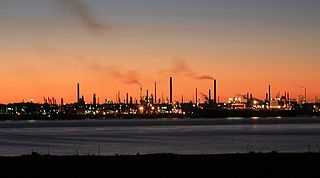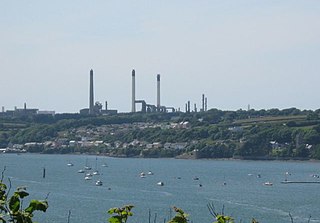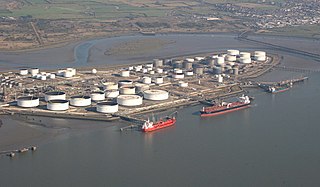
Tranmere Oil Terminal is situated on the River Mersey, 1.5 mi (2.4 km) south of Birkenhead. It was opened on 8 June 1960 to handle vessels of up to 65,000 tons, at two berths. It is connected to the Stanlow Oil Refinery by a 15 mi (24 km) pipeline. Part of the terminal occupies the site of a former ferry service to Liverpool, with the extant pier considerably modified.

Stanlow Refinery is an oil refinery owned by Essar Energy in Ellesmere Port, North West England. Until 2011 it was owned by Shell UK. The refinery is situated on the south bank of the Manchester Ship Canal, which is used to transport seaborne oil for refining and chemicals for Essar and Shell.
The Gujarat Refinery is an oil refinery located at Koyali, Vadodara District in Gujarat, Western India. It is the third largest refinery owned by Indian Oil Corporation after Paradip and Panipat Refinery. The refinery is currently under projected expansion to 18 million tonnes per year.

The Llandarcy Oil Refinery, also known as the National Oil Refinery, BP Llandarcy and Skewen refinery, was the United Kingdom's first oil refinery, initially opened by the Anglo-Persian Oil Company on 29 June 1922, although operations had begun on 1 July 1921. Before this, the only oil refined in the UK came from Scottish shale.

Coryton Refinery was an oil refinery in Essex, England, on the estuary of the River Thames 28 miles (45 km) from central London, between Shell Haven Creek and Hole Haven Creek, which separates Canvey Island from the mainland.
Onshore, when used in relation to hydrocarbons, refers to an oil, natural gas or condensate field that is under the land or to activities or operations carried out in relation to such a field.

Shell Haven was a port on the north bank of the Thames Estuary at the eastern end of Thurrock, Essex, England and then an oil refinery. The refinery closed in 1999 and the site was purchased by DP World who received planning consent in May 2007 for the new London Gateway deep water container port at the site. The neighbouring Coryton Refinery remained in operation until 2012.

Fawley Refinery is an oil refinery located at Fawley, Hampshire, England. The refinery is owned by Esso Petroleum Company Limited, a subsidiary of Exxon Mobil Corporation, which acquired the site in 1925. Situated on Southampton Water, it was rebuilt and extended in 1951 and is now the largest oil refinery in the United Kingdom, and one of the most complex refineries in Europe. With a capacity of 270,000 barrels (43,000 m3) per day, Fawley provides 20 percent of the UK's refinery capacity. An estimated 1000 people are employed at the site.

Grangemouth Refinery is a mature oil refinery complex located on the Firth of Forth in Grangemouth, Scotland, currently operated by Petroineos.

The BPRefinery (Kent) was an oil refinery on the Isle of Grain in Kent. It was commissioned in 1953 and had a maximum processing capacity of 11 million tonnes of crude oil per year. It was decommissioned in August 1982.
Nynas AB is a Swedish manufacturer of specialty naphthenic oils and bitumen products. Founded in 1928 as a national oil company with a traditional range of products, the company today supplies specialist products and niche markets.

The Gulf Refinery at Milford Haven was an oil refinery situated on the Pembrokeshire coast in Wales. The refinery, originally owned and operated by Gulf Oil, was opened in August 1968 by Queen Elizabeth II. The plant, constructed at a cost of approximately £35 million, produced a range of petroleum products and occupied an area of 300 acres. It was initially designed to process 60,000 barrels of crude oil per day. The capacity was increased to 119,000 barrels (18,900 m3) a day of oil.

The Clyde Refinery was a crude oil refinery located in Clyde, New South Wales, Australia, operating between 1925 and 2013. At the time of its closure it had a refinery capacity of 85,000 barrels per day (13,500 m3/d) and was the oldest operating oil refinery in Australia. It was operated by Shell Refining (Australia) Pty Ltd and owned by the Royal Dutch Shell.

Milford Haven Refinery was an oil refinery situated on the Pembrokeshire coast in Wales, United Kingdom. The refinery began operating in 1973 under Amoco's ownership, but in its final years it was owned by Murco Petroleum. The closure of the refinery was announced in November 2014. The site was sold to Puma Energy in 2015 for use as a petroleum storage and distribution terminal.
Gulf Petrochem Group is a company operating in the downstream and midstream sectors of the oil and energy industry. It has six divisions in Oil Trading and Bunkering, Oil Refining, Grease Manufacturing, Oil Terminals, Bitumen Manufacturing, and Shipping and Logistics.

Petroleum refining in the United Kingdom produced around 61 million tonnes of petroleum products in 2015, down 19% from 2011. There are six major and one minor petroleum refinery in the downstream sector of the UK oil industry.
Heysham oil refinery was located between Heysham and Middleton on the Heysham peninsula, Lancashire. It was built during the Second World War to produce high octane fuel for combat aircraft. It was later adapted to refine crude oil with a processing capacity of two million tonnes per year and was in operation from 1948 to 1976. It worked in conjunction with a chemical plant which produced ammonium nitrate fertilizer and other products, using feedstocks from the refinery.
The Teesside oil terminal is a major crude oil reception, processing, storage and export facility at Seal Sands, Middlesbrough. It receives and processes crude oil delivered by the subsea NORPIPE pipeline from the Norwegian Ekofisk field and the UK Fulmar and J-Block fields. The terminal includes facilities for exporting stabilised crude oil and liquefied petroleum gases (LPG) by tanker and pipeline.
The Whitegate refinery, near Whitegate, County Cork, is Ireland's only oil refinery. It has a capacity of 75,000 barrels of oil per day (bpd), sufficient to provide 40 percent of Ireland's fuel requirements. It was commissioned in 1959 and was redeveloped several times and produces a range of petroleum products.
Harwich refinery is a 500,000 tonnes per year refining, processing, blending and storage facility near the port of Harwich in the UK. The refinery was commissioned in 1964 to process petroleum-based feedstocks into specialist hydrocarbon solvents.












